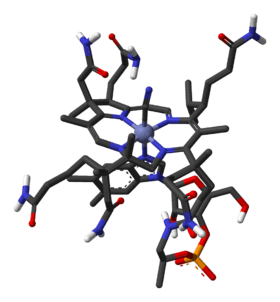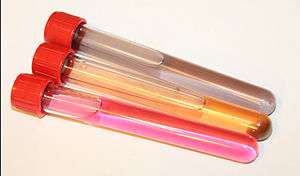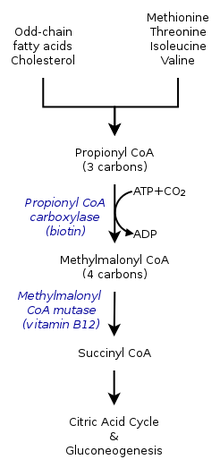Cyanocobalamin
 | |
 | |
| Identifiers | |
|---|---|
| 68-19-9 | |
| ChEMBL | ChEMBL1200658 |
| DrugBank | DB00115 |
| ECHA InfoCard | 100.000.618 |
| EC Number | 200-680-0 V09XX01 (WHO) (57Co) V09XX02 (WHO) (58Co) |
| UNII | P6YC3EG204 |
| Properties | |
| C63H88CoN14O14P | |
| Molar mass | 1355.38 g/mol |
| Appearance | Dark red solid |
| Melting point | > 300 °C |
| Boiling point | > 300 °C |
| Soluble | |
| Pharmacology | |
| B03BA01 (WHO) | |
| Hazards | |
| Safety data sheet | External MSDS from Fisher Scientific |
| EU classification (DSD) |
Not available |
| S-phrases | S24/25 |
| NFPA 704 | |
| Flash point | N/A |
| Except where otherwise noted, data are given for materials in their standard state (at 25 °C [77 °F], 100 kPa). | |
| | |
| Infobox references | |
Cyanocobalamin is a synthetic form of vitamin B
12. Vitamin B
12 is the "generic descriptor" name for any vitamers of vitamin B
12. Because humans and animals can convert cyanocobalamin to any one of the active vitamin B
12 compounds,[1] by definition this makes cyanocobalamin itself a form (or vitamer) of B
12.
Chemical properties
Cyanocobalamin is one of the most widely manufactured vitamers in the vitamin B
12 family (the family of chemicals that function as B
12 when put into the body), because cyanocobalamin is the most air-stable of the B
12 forms. It is the easiest to crystallize and therefore easiest to purify after it is produced by bacterial fermentation, or synthesized in vitro. It can be obtained as dark red crystals or as an amorphous red powder. Cyanocobalamin is hygroscopic in the anhydrous form, and sparingly soluble in water (1:80). It is stable to autoclaving for short periods at 121 °C (250 °F). The vitamin B
12 coenzymes are unstable in light. After consumption the cyanide ligand is replaced by other groups (adenosyl, methyl), which are the biologically active forms. The cyanide is excreted.
Chemical reactions
In the cobalamins, cobalt normally exists in the trivalent state, Co(III). However, under reducing conditions, the cobalt center is reduced to Co(II) or even Co(I), which are usually denoted as B
12rand B
12s, for reduced and super reduced, respectively.
B
12r and B
12scan be prepared from cyanocobalamin by controlled potential reduction, or chemical reduction using sodium borohydride in alkaline solution, zinc in acetic acid, or by the action of thiols. Both B
12r and B
12sare stable indefinitely under oxygen-free conditions. B
12r appears orange-brown in solution, while B
12sappears bluish-green under natural daylight, and purple under artificial light.[2]
B
12sis one of the most nucleophilic species known in aqueous solution. This property allows the convenient preparation of cobalamin analogs with different substituents, via nucleophilic attack on alkyl halides and vinyl halides.[2]
For example, cyanocobalamin can be converted to its analog cobalamins via reduction to B
12s, followed by the addition of the corresponding alkyl halides, acyl halides, alkene or alkyne. Steric hindrance is the major limiting factor in the synthesis of the B
12 coenzyme analogs. For example, no reaction occurs between neopentyl chloride and B
12s, whereas the secondary alkyl halide analogs are too unstable to be isolated.[2] This effect may be due to the strong coordination between benzimidazole and the central cobalt atom, pulling it down into the plane of corrin ring. The trans effect determines the polarizability of the Co-C bond so formed. However, once the benzimidazole is detached from cobalt by quaternization with methyl iodide, it is replaced by H
2O or hydroxyl ions. Various secondary alkyl halides are then readily attacked by the modified B
12sto give the corresponding stable cobalamin analogs.[3] The products are usually extracted and purified by phenol-methylene chloride extraction or by column chromatography.[2]
Cobalamin analogs prepared by this method include the naturally occurring coenzymes methylcobalamin and cobamamide, and other cobalamins that do not occur naturally, such as vinylcobalamin, carboxymethylcobalamin and cyclohexylcobalamin.[2] This reaction is under review for use as a catalyst for chemical dehalogenation, organic reagent and photosensitized catalyst systems.[4]

Production
Cyanocobalamin is commercially prepared by bacterial fermentation. Fermentation by a variety of microorganisms yields a mixture of methyl-, hydroxo- and adenosylcobalamin. These compounds are converted to cyanocobalamin by addition of potassium cyanide in the presence of sodium nitrite and heat. Since multiple species of Propionibacterium produce no exotoxins or endotoxins and have been granted GRAS status (generally regarded as safe) by the United States Food and Drug Administration, they are the preferred bacterial fermentation organisms for vitamin B
12 production.[5]
Historically, a form of vitamin B
12 called hydroxocobalamin is often produced by bacteria and was then changed to cyanocobalamin during purification in activated charcoal columns after separation from the bacterial cultures. This change was not immediately realized when vitamin B
12 was first extracted for characterization. Cyanide is naturally present in activated charcoal. Hydroxocobalamin, which has affinity for cyanide, picks it up and changes to cyanocobalamin. Cyanocobalamin is the form in most pharmaceutical preparations because adding cyanide stabilizes the molecule.[6]
France accounts for 80% of the world's 10+ tonnes/year of production. 55% of sales is destined for animal feed, while the remaining 45% is for human consumption.[7]
Pharmaceutical use
Cyanocobalamin is usually prescribed after surgical removal of part or all of the stomach or intestine to ensure adequate serum levels of vitamin B
12. It is also used to treat pernicious anemia, vitamin B
12 deficiency (due to low intake from food), thyrotoxicosis, hemorrhage, malignancy, liver disease and kidney disease. Cyanocobalamin injections are often prescribed to gastric bypass patients who have had part of their small intestine bypassed, making it difficult for B
12 to be acquired via food or vitamins. Cyanocobamide is also used to perform the Schilling test to check ability to absorb vitamin B
12.[8]
Cyanide poisoning treatment
In cases of cyanide poisoning the patient is given hydroxocobalamin, which is a precursor to cyanocobalamin. The hydroxocobalamin binds with the cyanide ion and forms cyanocobalamin, which can be excreted by the kidneys. This has been used for many years in France and was approved by the FDA in December 2006, marked under the name Cyanokit.[9][10] An apparent paradox is that hydroxocobalamin is given in large doses to bind to cyanide in situations of cyanide exposure (most commonly in smoke from a building fire), creating cyanocobalamin which is then excreted in urine, yet cyanocobalamin can be consumed as a pre-vitamin, releasing cyanide when converted to the bioactive forms methylcobalamin and adenosylcobalamin. Considering the dose resolves the paradox. Little dietary cyanocobalamin converted, while the rest is either not absorbed, or absorbed and excreted in urine unchanged.
Possible side effects
Oral use of cyanocobalamin may lead to skin problems or immunological reactions such as itching and anaphylactic shock.[11] Possible side effects of cyanocobalamin injection include allergic reactions such as hives, difficult breathing; redness of the face; swelling of the arms, hands, feet, ankles or lower legs; extreme thirst; and diarrhea. Less-serious side effects may include headache, dizziness, leg pain, itching, or rash.[12]
Treatment of megaloblastic anemia with concurrent vitamin B
12 deficiency using B
12 vitamers (including cyanocobalamin), creates the possibility of hypokalemia due to increased erythropoiesis (red blood cell production) and consequent cellular uptake of potassium upon anemia resolution.[13] When treated with vitamin B
12, patients with Leber's disease may suffer serious optic atrophy, possibly leading to blindness.[14]
Vitamin B12 metabolism
The two bioactive forms of vitamin B
12r are methylcobalamin in cytosol and adenosylcobalamin in mitochondria. Multivitamins often contain cyanocobalamin, which is presumably converted to bioactive forms in the body. Both methylcobalamin and adenosylcobalamin are commercially available as supplement pills. The MMACHC gene product catalyzes the decyanation of cyanocobalamin as well as the dealkylation of alkylcobalamins including methylcobalamin and adenosylcobalamin.[15] This function has also been attributed to cobalamin reductases.[16] The MMACHC gene product and cobalamin reductases enable the interconversion of cyano- and alkylcobalamins.[17]
B12 cyanocobalamin is added to fortify[18] nutrition, including baby milk powder, breakfast cereals and energy drinks for humans, also animal feed for poultry, swine and fish. Vitamin B
12 becomes inactive due to Hydrogen cyanide HCN and Nitric oxide NO in cigarette smoke. Vitamin B
12 becomes inactive due to Nitrous oxide N
2O commonly known as laughing gas, used for anaesthesia. Vitamin B
12 becomes inactive due to microwave or other forms of heating.[19] This all leads to vitamin B12 deficiency and serious diseases, especially for babies and the elderly.
Vitamin B12 is the catalyst of Carbon biochemistry (Methionine cycle, SAMe, DNA, proteins and PEMT) – the Cobalt ion coordinates C as in MUT enzyme molecule (PDB 4REQ).
In the cytosol
Vitamin B
12 methylcobalamin and 5-methyltetrahydrofolate are needed by Methionine synthase in the Methionine cycle to transfer a methyl group from 5-methyltetrahydrofolate to homocysteine, thereby generating tetrahydrofolate (THF) and methionine, which is used to make SAMe.
SAMe is the universal methyl donor and is used for DNA methylation and to make phospholipid membranes, choline, sphingomyelin and acetylcholine and other neurotransmitters. Methionine is also the start codon (AUG) in the genetic code, and so protein biosynthesis begins with methionine.
In the Transsulfuration pathway, homocysteine is converted first into cystathionine and then into cysteine and propionyl-CoA.
In Mitochondria

The enzymes that use B
12 as a built-in cofactor are Methylmalonyl-CoA mutase (PDB 4REQ[20]) and Methionine synthase (PDB 1Q8J).[21]
The metabolism of propionyl-CoA occurs in the mitochondria and requires Vitamin B
12 (as adenosylcobalamin) to make succinyl-CoA. When the conversion of propionyl-CoA to succinyl-CoA in the mitochondria fails due to Vitamin B
12 deficiency, elevated blood levels of methylmalonic acid MMA occur. Thus, elevated blood levels of homocysteine and methylmalonic acid MMA may both be indicators of Vitamin B
12 deficiency.
Vitamin B
12 adenosylcobalamin is needed as cofactor in Methylmalonyl-CoA mutase—MUT enzyme. Processing of cholesterol and protein gives propionyl-CoA that is converted to methylmalonyl-CoA, which is used by MUT enzyme to make succinyl-CoA.
Succinyl-CoA is needed to make heme for hemoglobin and it is used in the citric acid cycle to make ATP chemical energy molecules.
Vitamin B
12 is needed to prevent anemia, since making porphyrin and heme in mitochondria for producing hemoglobin in red blood cells depends on succinyl-CoA made by vitamin B
12.
This part of biochemistry in the mitochondria needs adequate supply of vitamin B
12 adenosylcobalamin, biotin, iron and magnesium ions.
Absorption and transport
Poor absorption of vitamin B
12 may be related to coeliac disease. Intestinal absorption of vitamin B
12 requires successively three different protein molecules: Haptocorrin, Intrinsic Factor and Transcobalamin II. The structure of these proteins is available in the Protein Data Bank.[22] - Intrinsic Factor (PDB 3KQ4)[23] - Transcobalamin II (PDB 2BB5).[24]
See also
References
- ↑ Quadros, EV. "Advances in the Understanding of Cobalamin Assimilation and Metabolism". Br J Haematol. 2010 Jan; 148(2): 195–204.
- 1 2 3 4 5 David Dophin. Preparation of the Reduced Forms of Vitamin B
12 and of Some Analogs of the Vitamin B
12 Coenzyme Containing a Cobalt-Carbon Bond. D.B. McCormick and L.D. Wright, Eds. 1971;Vol. XVIII:34-54. - ↑ Brodie, J. D. (1969). "On the mechanism of catalysis by vitamin B12". Proceedings of the National Academy of Sciences of the United States of America. 62 (2): 461–7. Bibcode:1969PNAS...62..461B. doi:10.1073/pnas.62.2.461. PMC 277821
 . PMID 5256224.
. PMID 5256224. - ↑ Shimakoshi, Hisashi; Yoshio Hisaeda. "Environmental-friendly catalysts learned from Vitamin B
12-dependent enzymes" (PDF). TCIMAIL. 128: 2. - ↑ Riaz, Muhammad; Fouzia Iqbal; Muhammad Akram (2007). "Microbial production of vitamin B12 by methanol utilizing strain of Pseudomonas specie". Pak J. Biochem. Mol. Biol. 1. 40: 5–10.
- ↑ Herbert, V (1988). "Vitamin B-12: Plant sources, requirements, and assay". The American Journal of Clinical Nutrition. 48 (3 Suppl): 852–8. PMID 3046314.
- ↑ Kaesler, Bruno (2005), "Vitamins: 9. Vitamin B12 (Cyanocobalamins)", Ullmann's Encyclopedia of Industrial Chemistry, Weinheim: Wiley-VCH, doi:10.1002/14356007.a27_443
- ↑ Cyanocobalamin. University of Maryland Medical Center
- ↑ Bledsoe, Bryan (2009). Paramedic Care: Principles & Practice, Medical Emergencies. Upper Saddle River, New Jersey: Pearson Education, Inc. p. 471. ISBN 978-0-13-513702-4.
- ↑ Hamel, J. (2011). "A Review of Acute Cyanide Poisoning with a Treatment Update". Critical Care Nurse. 31: 72–82. doi:10.4037/ccn2011799. PMID 21285466.
- ↑ "Cyanocobalamin (Cyanocobalamin 50microgram tablets). Side effects". NHS Choices. Archived from the original on 4 July 2015. Retrieved 4 July 2015.
- ↑ "Cyanocobalamin Injection". MedlinePlus. Archived from the original on 19 April 2015. Retrieved 4 July 2015.
- ↑ "Clinical Vitamin B12 Deficiency. Managing Patients". Centers for Disease Control and Prevention. Archived from the original on 26 April 2015. Retrieved 4 July 2015.
- ↑ "Vitamin B12". MedlinePlus. Archived from the original on 5 April 2015. Retrieved 4 July 2015.
- ↑ Hannibal, Luciana; Kim, Jihoe; Brasch, Nicola E.; Wang, Sihe; Rosenblatt, David S.; Banerjee, Ruma; Jacobsen, Donald W. (Aug 2009). "Processing of alkylcobalamins in mammalian cells: a role for the MMACHC (cblC) gene product". Mol Genet Metab. 97 (4): 260–266. doi:10.1016/j.ymgme.2009.04.005. PMC 2709701
 . PMID 19447654.
. PMID 19447654. - ↑ Watanabe, F; Nakano, Y (1997). "Purification and characterization of aquacobalamin reductases from mammals". Methods Enzymol. 281: 295–305.
- ↑ Quadros EV, Jackson B, Hoffbrand AV, Linnell JC. "Interconversion of cobalamins in human lymphocytes in vitro and the influence of nitrous oxide on the synthesis of cobalamin coenzymes". Vitamin B12, Proceedings of the Third European Symposium on Vitamin B12 and Intrinsic Factor. 1979;1045-1054.
- ↑ "DSM in Food, Beverages & Dietary Supplements". DSM. Retrieved 2 March 2015.
- ↑ Watanabe, F; Abe, K; Fujita, T; Goto, M; Hiemori, M; Nakano, Y (Jan 19, 1998). "Effects of Microwave Heating on the Loss of Vitamin B(12) in Foods". J Agric Food Chem. 46 (1): 206–210. doi:10.1021/jf970670x. PMID 10554220. Retrieved 3 March 2015.
- ↑ F, Mancia,; P.R., Evans, (1 January 1998). "Conformational changes on substrate binding to methylmalonyl CoA mutase and new insights into the free radical mechanism.". 6.
- ↑ J.C, Evans,; D.P, Huddler,; M.T, Hilgers,; G, Romanchuk,; R.G, Matthews,; M.L., Ludwig, (1 January 2004). "Structures of the N-terminal modules imply large domain motions during catalysis by methionine synthase.". 101.
- ↑ E, Furger,; D.C, Frei,; R, Schibli,; E, Fischer,; A.E., Prota, (1 January 2013). "Structural basis for universal corrinoid recognition by the cobalamin transport protein haptocorrin.". 288.
- ↑ C.B, Andersen,; M, Madsen,; T, Storm,; S.K, Moestrup,; G.R., Andersen, (1 January 2010). "Structural basis for receptor recognition of vitamin-B(12)-intrinsic factor complexes.". 464.
- ↑ J, Wuerges,; G, Garau,; S, Geremia,; S.N, Fedosov,; T.E, Petersen,; L., Randaccio, (1 January 2006). "Structural basis for mammalian vitamin B12 transport by transcobalamin.". 103.
